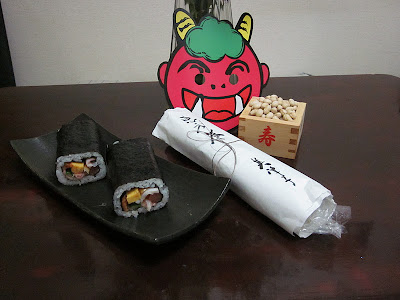Feb. 3rd, 2011:
Setsubun (節分) is one of Japan's unique holidays occuring every year on February 3rd. The meaning behind the holiday is that of a spring cleaning. While most people think of spring cleaning as the obnoxious mind-numbing work of cleaning the areas of your house that aren't touched in a year exactly because they're dirty; Setsubun happens to be a little more exciting with a spring cleaning of demons and evil spirits.
Setsubun relates to the Lunar New Year and is a holiday whose origins were Chinese. Setsubun is the day before the start of spring and the Lunar New Year, so it was a day to remove the evil spirits and bad luck of the previous year and to allow good luck into the home for the next year. This is done with a custom called Mamemaki (豆撒き).
Mamemaki is the act of driving out the demons and bad spirits out of the household. This is usually done in the entertaining fashion of someone wearing a demon mask and everyone else throwing beans at them. This is done while saying, "Oni wa soto! Fuku wa uchi!" (鬼は外! 福は内!). The English meaning is, "Demons out! Luck in!" The tradition of Mamemaki was introduced in the Muromachi Period (1336-1573) and uses roasted soybeans called fukumame (福豆) or 'fortune beans.' After throwing them at the person wearing the demon mask to get rid of the evil spirits, people also eat the 'fortune beans' for good luck in the coming year. People eat the amount of fukumame that equals the number of years old they are plus one in order to get good luck for the next year. We participated in this only a little, as the mess from the bean throwing seemed to be more daunting than the trouble from the demons.
Actually, this practice is not as common at homes any more and more often is done at a shrine or temple. Some of these events are very popular due to money, candy and even prizes being thrown out into the crowds along with the beans. Another traditional practice that is no longer commonly done (maybe thankfully) was the hanging of burning dried sardine heads outside of the home, a practice started in the 13th century as the evil spirits did not like the bad smells. [1]
However, a more popular Setsubun tradition that we did participate in is eating Setsubun's traditional food and the customs involved in eating it. Setsubun's custom food is an uncut Makizushi called Eho-Maki (恵方巻), meaning 'lucky direction roll.'
There is a special way to eat this food in order to receive good luck for the year. The Eho-Maki must be eaten all at one time while facing in the lucky direction for that year in silence and with eyes closed. The direction is determined based on the zodiac animal for that year. In 2011, the lucky direction was south-southeast. While eating makizushi cut into slices isn't too bad, it's difficult to try and eat the whole roll uncut. It was a fun experience and if it works like it should, we should have good luck for the next year.
Setsubun is an interesting holiday I would have had no idea about except for being here. While I don't necessarily believe in the aspects of the holiday, it's fun to learn and participate in the holiday's traditions. For next year especially, I have to convince my girlfriend to have us participate more in the actual bean throwing.
References:
1. "Setsubun," japan-guide.com.
http://www.japan-guide.com/e/e2285.html.


No comments:
Post a Comment